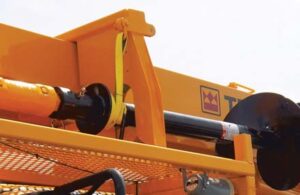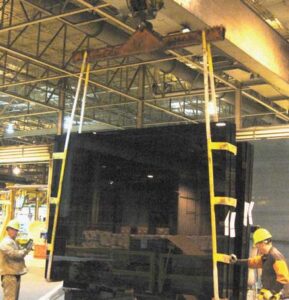Synthetic Slings
Penco® Stone Handling Slings
With natural untreated webbing, Penco® Stone Handling Slings are ideally suited for handling polished granite, concrete
panels and marble blocks. Available in 4” width only.

Penco® Cargo Slings

- Designed as a wide-body sling where extra width is critical. Used only in a basket hitch
- Provides better balance and load distribution. Available in widths 6” thru 24”
- Special wide-body slings above 24” are available upon request
Lumber Sorter Slings
- Lumber Sorter Slings are used specifically in saw mill operations.
- The slings are fabricated with aluminum or flame cut fitting on one end.
- The other end is a sewn

PIN # | Width | Ply | Rated Capacity |
LS1904 | 4” | 1 | 12,800 lbs |
Auger Slings
- Designed to quick lift and secure the drilling auger
to the truck boom. - The auger sling, in swift wrap around action, lifts
the auger to the boom where it is held securely in
travel position. - The nylon webbing will hang straight from the
boom when not in use, will not curl or kink. - Most common lengths 8’ 6” | 9’ 0” | 10’ 0” | 10’ 6”
- Rated Capacity: Vertical 2,400 lbs | Choker 1,900
lbs.

Glass Handling Sling
- Glass Handling Slings are used to move the glass from
the production line to the shipping/crating area. - Standard Duty Glass Handling Slings utilize two plies
of 2” polyester material sewn in a configuration to
provide stabile, controlled transport of the glass panels.
These slings are rated to 12,200 lbs when used in a
vertical basket. - Heavy duty Glass Handling Slings use two plies of 4”
polyester webbing and are rated to 20,700 lbs when
used in a vertical basket. - Both Standard Duty and Heavy Duty have a felt lining
sewn in the areas that contact the glass. This lining
protects the webbing from marring the glass and the
glass from cutting the webbing. - Many of these slings are custom designed to the
specific requirements of the glass manufacturer.

Initial Inspection – Before using any new, repaired, or modified sling, it shall be inspected to ensure that the correct sling is being used as well as to determine that the sling meets the B30.9-5 Standard.
Frequent Inspection – This inspection should be made by the person handling the sling each day the sling is used.
Periodic Inspection – This inspection should be conducted by designated personnel. Frequency of inspection should be based on: Frequency of Use, Severity of Service Conditions, and Experience Gained on the Service Life of Slings Used in Similar Applications.
Inspection Records – Written inspection records, utilizing the identification for each sling as established by the user, should be kept for all slings. These records should show a description of the new sling and its condition on each periodic inspection.
Removal Criteria
A sling shall be removed from service if damage such as the following is visible and shall only be returned to service when approved by a designated person.
- Missing or illegible sling identification
- Acid or caustic burns
- Melting or charring of any part of the sling
- Holes, tears, cuts, or snags
- Broken or worn stitching in load bearing splices
- Excessive abrasive wear
Operating Practices
- Knots in any part of the sling
- Excessive pitting or corrosion, or cracked, distorted or broken fittings
- Red warning yarns are visible in the body of the sling
- Other visible damage that causes doubt as to the strength of the sling
- Slings having suitable characteristics for the type of load, hitch, and environment shall be selected in accordance with appropriate
- The weight of load shall be within the rated load of the (Sling Angles have a dramatic affect on rated load).
- Slings shall be shortened, lengthened, or adjusted only by methods approved by the sling
- Slings shall not be shortened or lengthened by
- Slings that appear to be damaged shall not be used unless inspected and accepted as usable under the Inspection and Removal
- Slings shall be hitched in a manner providing control of the
- Sharp corners in contact with the sling should be padded with material of sufficient strength to minimize damage to the
- All portions of the human body shall be kept from between the sling and the load, and from between the sling and the crane hook or hoist
- Personnel should stand clear of the suspended
- Personnel should not ride the
- Shock loading should be
- Slings should not be pulled from under a load when the load is resting on the
- Slings should be stored in a cool, dry, and dark place to prevent environmental
- Twisting and kinking the legs shall be
- Load applied to the hook should be centered in the base (bowl) of hook to prevent point loading on the
- During lifting, with or without load, personnel shall be alert for possible
- In a basket hitch, the load should be balanced to prevent
- The sling’s legs should contain or support the load from the sides above the center of gravity when using a basket
- Slings should be long enough so that the rated load is adequate when the angle of the legs is taken into
- Slings should not be dragged on the floor or over an abrasive
- In a choker hitch, slings shall be long enough so the choker fitting chokes on the webbing and never on another
- Nylon and polyester slings shall not be used in contact with object or at temperatures in excess of 194oF (90oC) or below -40oF (-40oC).
- When extensive exposure to sunlight or ultraviolet light is experienced by nylon or polyester web slings, the sling manufacturer should be consulted for recommended inspection procedure.
Note:
Additional information and safe operating practices are outlined in current OSHA and ANSI/ASME B30.9c Standards as applicable, pertaining to Lifting assemblies.
Operating practices are outlined in current Commercial Vehicle Safety Alliance (CVSA) guidelines for Federal, State, and Provincial
practices pertaining to Tiedown Assemblies.
Web Sling Inspection

